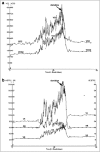Hypothesis: Fever control, a niche for alpha-2 agonists in the setting of septic shock and severe acute respiratory distress syndrome?
- PMID: 30393754
- PMCID: PMC6209424
- DOI: 10.1080/23328940.2018.1453771
Hypothesis: Fever control, a niche for alpha-2 agonists in the setting of septic shock and severe acute respiratory distress syndrome?
Abstract
During severe septic shock and/or severe acute respiratory distress syndrome (ARDS) patients present with a limited cardio-ventilatory reserve (low cardiac output and blood pressure, low mixed venous saturation, increased lactate, low PaO2/FiO2 ratio, etc.), especially when elderly patients or co-morbidities are considered. Rescue therapies (low dose steroids, adding vasopressin to noradrenaline, proning, almitrine, NO, extracorporeal membrane oxygenation, etc.) are complex. Fever, above 38.5-39.5°C, increases both the ventilatory (high respiratory drive: large tidal volume, high respiratory rate) and the metabolic (increased O2 consumption) demands, further limiting the cardio-ventilatory reserve. Some data (case reports, uncontrolled trial, small randomized prospective trials) suggest that control of elevated body temperature ("fever control") leading to normothermia (35.5-37°C) will lower both the ventilatory and metabolic demands: fever control should simplify critical care management when limited cardio-ventilatory reserve is at stake. Usually fever control is generated by a combination of general anesthesia ("analgo-sedation", light total intravenous anesthesia), antipyretics and cooling. However general anesthesia suppresses spontaneous ventilation, making the management more complex. At variance, alpha-2 agonists (clonidine, dexmedetomidine) administered immediately following tracheal intubation and controlled mandatory ventilation, with prior optimization of volemia and atrio-ventricular conduction, will reduce metabolic demand and facilitate normothermia. Furthermore, after a rigorous control of systemic acidosis, alpha-2 agonists will allow for accelerated emergence without delirium, early spontaneous ventilation, improved cardiac output and micro-circulation, lowered vasopressor requirements and inflammation. Rigorous prospective randomized trials are needed in subsets of patients with a high fever and spiraling toward refractory septic shock and/or presenting with severe ARDS.
Keywords: acute respiratory distress syndrome; clonidine; dexmedetomidine; fever control; high PEEP; hyperthermia; hypothermia; septic shock; spontaneous breathing; sympathetic system.
Figures













Similar articles
-
Building on the Shoulders of Giants: Is the use of Early Spontaneous Ventilation in the Setting of Severe Diffuse Acute Respiratory Distress Syndrome Actually Heretical?Turk J Anaesthesiol Reanim. 2018 Sep;46(5):339-347. doi: 10.5152/TJAR.2018.01947. Epub 2018 Sep 1. Turk J Anaesthesiol Reanim. 2018. PMID: 30263856 Free PMC article. Review.
-
Surviving sepsis campaign: international guidelines for management of severe sepsis and septic shock: 2012.Crit Care Med. 2013 Feb;41(2):580-637. doi: 10.1097/CCM.0b013e31827e83af. Crit Care Med. 2013. PMID: 23353941
-
Is there a place for pressure-support ventilation and high positive end-expiratory pressure combined to alpha-2 agonists early in severe diffuse acute respiratory distress syndrome?Med Hypotheses. 2013 Jun;80(6):732-7. doi: 10.1016/j.mehy.2013.02.023. Epub 2013 Apr 3. Med Hypotheses. 2013. PMID: 23561575
-
Improved understanding of the respiratory drive pathophysiology could lead to earlier spontaneous breathing in severe acute respiratory distress syndrome.Eur J Anaesthesiol Intensive Care. 2023 Aug 24;2(5):e0030. doi: 10.1097/EA9.0000000000000030. eCollection 2023 Oct. Eur J Anaesthesiol Intensive Care. 2023. PMID: 39916810 Free PMC article.
-
Early severe acute respiratory distress syndrome: What's going on? Part I: pathophysiology.Anaesthesiol Intensive Ther. 2016;48(5):314-338. doi: 10.5603/AIT.2016.0056. Anaesthesiol Intensive Ther. 2016. PMID: 28000204 Review.
Cited by
-
Potential for Further Mismanagement of Fever During COVID-19 Pandemic: Possible Causes and Impacts.Front Med (Lausanne). 2022 Mar 2;9:751929. doi: 10.3389/fmed.2022.751929. eCollection 2022. Front Med (Lausanne). 2022. PMID: 35308547 Free PMC article.
-
Clinical Practice: Should we Radically Alter our Sedation of Critical Care Patients, Especially Given the COVID-19 Pandemics?Rom J Anaesth Intensive Care. 2020 Dec;27(2):43-76. doi: 10.2478/rjaic-2020-0018. Epub 2021 Jan 4. Rom J Anaesth Intensive Care. 2020. PMID: 34056133 Free PMC article.
-
Is the Sympathetic System Detrimental in the Setting of Septic Shock, with Antihypertensive Agents as a Counterintuitive Approach? A Clinical Proposition.J Clin Med. 2021 Oct 1;10(19):4569. doi: 10.3390/jcm10194569. J Clin Med. 2021. PMID: 34640590 Free PMC article. Review.
-
Combining O2 High Flow Nasal or Non-Invasive Ventilation with Cooperative Sedation to Avoid Intubation in Early Diffuse Severe Respiratory Distress Syndrome, Especially in Immunocompromised or COVID Patients?J Crit Care Med (Targu Mures). 2024 Oct 31;10(4):291-315. doi: 10.2478/jccm-2024-0035. eCollection 2024 Oct. J Crit Care Med (Targu Mures). 2024. PMID: 39916864 Free PMC article. Review.
-
Dexmedetomidine Combined with Low-Dose Norepinephrine Continuous Pumping to Prevent Hypotension after Cesaresan Section: A Randomized Controlled Trial.J Healthc Eng. 2023 Feb 4;2023:5324055. doi: 10.1155/2023/5324055. eCollection 2023. J Healthc Eng. 2023. PMID: 36785841 Free PMC article. Clinical Trial.
References
-
- Laborit H, Huguenard P. Technique actuelle de l'hibernation artificielle. Presse Med. 1952;60:1455–1456. PMID:13027061 - PubMed
-
- Chippaux C, Carayon A, Rouffilange F, et al. . Artificial hibernation in war surgery: with reference to its use in Indochina. Presse Med. 1954;62:504–506. L'hibernation artificielle en chirurgie de guerre: d'apres son emploi actuel en Indochine. PMID:13166963 - PubMed
-
- Schortgen F. Fever in sepsis. Minerva Anestesiol. 2012;78:1254–1264. PMID:22772856 - PubMed
Publication types
LinkOut - more resources
Full Text Sources
